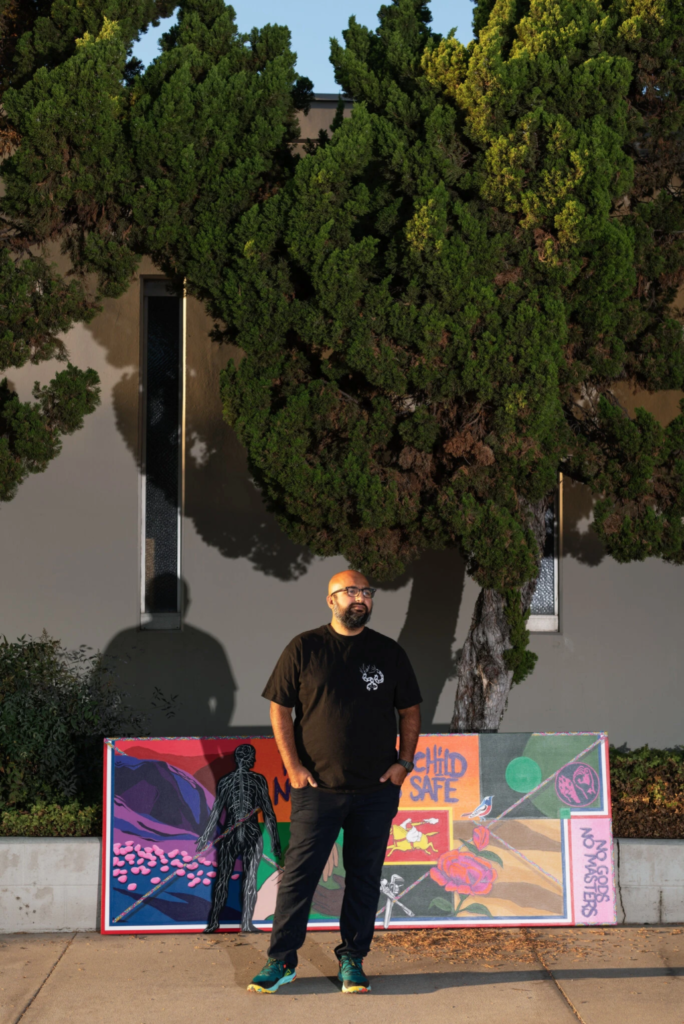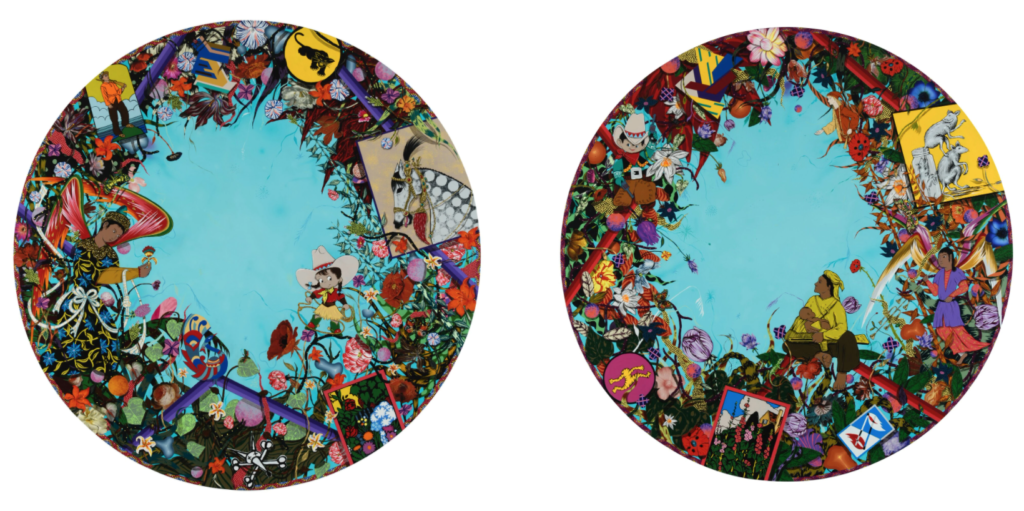Read on The New York Times
Come to Vote, Stay for the Art
In California, the Institute of Contemporary Art San José will open for voting, with a mural by Amir H. Fallah on display.

By Carol Pogash
Sept. 23, 2020
While many California museums are still shuttered because of the coronavirus, and others are opening slowly at limited capacity, the Institute of Contemporary Art San José has come up with an ingenious solution to open the museum, legally, for four days.
Starting on Oct. 31 through Election Day, the museum will become a polling site. Alison Gass, its executive director, is hoping that civic-minded citizens will stream through the museum to vote and take time to appreciate the art inside (a local art exhibition called “Personal Alchemy”) and out.
It will be hard not to notice.
A 50-foot vinyl mural by the Iranian-born artist Amir H. Fallah will wrap around the museum’s facade, and two six-foot circular paintings of his will slowly rotate in two windows.

In his mural, titled “Remember This,” messages in vibrant colors read: “REMEMBER MY CHILD NOWHERE IS SAFE”; “THEY WILL SMILE TO YOUR FACE”; and “A BORDERLESS WORLD,” along with other text. By “child,” Mr. Fallah means his younger self — by the age of 6, he had lived in four countries (Iran, Italy, Turkey and the United States) — and his 5-year-old son. “In America, people have a false sense of security,” he said in a recent interview.
In late July, Ms. Gass, who also is the museum’s chief curator, asked Mr. Fallah to paint a mural that addressed “the social and political conditions happening in this election and beyond.” He told her that was what he was thinking about, too. His paintings would appear outside of the institute, “because we wanted a safe way for people to see art,” Ms. Gass said.
A few days later, she met with her longtime collaborator, Florie Hutchinson, who was about to become the museum’s director of external relations. Ms. Hutchinson thought of a way for more people to see Mr. Fallah’s art: Make the institute a polling place.
“Many people in the past voted at their neighbor’s garage or in retirement homes,” said Alex Padilla, California’s secretary of state. That is no longer possible. California is promoting vote by mail “as a preferred option,” Mr. Padilla said. But for those wanting to vote in person, he said, counties have become “more creative.”
Santa Clara County, of which San Jose is the county seat, will be using libraries, empty schools, City Hall Council chambers, another museum and even a police department,said Paulo Chang, the county registrar of voters, election division coordinator.
As people enter the polling place, Mr. Fallah said, “I want them to think about what their vote means, how it affects everyone and everything around them.”

Mr. Fallah said his paintings for the museum are self-portraits with imagery from disparate cultures that express injustices all over the world. “This is a pretty political mural, but it doesn’t say to vote one way or another,” he added.
(California does not allow anyone within 100 feet of a polling place to engage in electioneering, which refers to displays of a candidate’s name, likeness on buttons, hats or signs. It says nothing about art that addresses anxieties or calls for more empathy.)
An American citizen, Mr. Fallah, 41, who lives in Los Angeles, said he has experienced what he calls the abuse of government power firsthand. In January 2017, when President Trump closed the nation’s borders to refugees and suspended immigration from several predominantly Muslim countries, he was detained “in a basement room at Newark Airport with other brown people,” almost all of whom were citizens, he said. He said his passport was taken from him.
Mr. Fallah’s paintings reflect his fears that “the world is getting darker and darker,” he said. His concerns include but are not limited to “the environment, the treatment of children by ICE, racism, social injustice, an almost war with Iran for no reason,” he said.
Mr. Fallah is also designing a giveaway button that says: “Vote like your life depends on it.” That message will be on signs in city bus shelters and on streetlight poles.
“We were poised to be nimble, especially in a moment of unimaginable crisis for arts organizations,” Ms. Gass said.
The institute, which used to be called the San Jose Institute of Contemporary Art but was recently renamed, occupies a red brick, one-story building in downtown San Jose, the third-largest city in California, which Sam Liccardo, its mayor, has called “a city of immigrants.” As of 2014, 38 percent of residents were immigrants, including an Iranian community.
The institute, which is celebrating its 40th year, usually sees 30,000 visitors annually and has a $1.5 million budget. It received some assistance from the Paycheck Protection Program and has kept all seven employees.
At the end of July, Ms. Gass, the former director of University of Chicago’s Smart Museum of Art, was sitting on a curb in Palo Alto, sipping ice coffee with Ms. Hutchinson. They wanted Mr. Fallah’s art to be seen by as many people as possible during “this most important election of our lifetime,” Ms. Hutchinson said.
The next day, in the shower, Ms. Hutchinson said, it came to her: “What if there’s a way we can open the building for the purposes of letting people vote?”
Ms. Hutchinson was familiar with the California Voter’s Choice Act, which is designed to make voting more convenient. It decouples voting from neighborhoods by offering “vote centers,” larger venues near parking and transit hubs. Voters can choose any center countywide.

RIGHT: “Cowboy,” the second rotating artwork that will be at the voting center. Both paintings use images from the “debris of life” he finds on the internet.Credit…Amir H. Fallah and Shulamit Nazarian, Los Angeles
“Throughout my career I’ve been drawn to art that is about politics,” such as Mr. Fallah’s work, Ms. Gass said, “in which you begin to find meaning for yourself.” She chose an artist from an underrepresented group: “artists from countries not given a big platform in American museums.” His work “is bound up in American identity and the immigrant experience,” she added, calling it “beautiful and disturbing.”
Mr. Fallah’s art has been exhibited worldwide in over 100 shows. He is best known for his veiled people — concealed behind gorgeously patterned fabrics. His work was featured in an online exhibition last spring called “How Can We Think of Art at a Time Like This?”
His painting is 16 feet by 3 feet. Through the use of high-resolution photography, it has been enlarged and printed on vinyl as a mural. It and the two circular paintings are mash-ups: Ancient script is set against skateboarders’ graffiti, Persian miniature horses against the Black Panthers logo. The circular paintings represent Earth and are edged with “the chaotic mesh of plant life,” he said. One is called “Cowboy,” the other “Cowgirl,” inspired by vintage Valentines. Mixed in are images of a Cambodian propaganda figure, mythical figures from old match boxes, “debris of life” that he finds online. When the paintings rotate, plants and cultures will tumble onto one another.
Explanatory text will appear in five languages, including Spanish, Mandarin, Vietnamese and Farsi.
Mr. Fallah said he hoped his art would make people “stop in their tracks and think about what their vote means.”
“The big thing missing in our society is empathy,” he said. Will his art make people care about others? “Will it? I don’t know,” he said. “That’s my desire.”
Correction: Sept. 23, 2020
An earlier version of this article in one instance referred incorrectly to Amir Fallah’s work. His painting is 16 feet by 3 feet, not the mural; the much-larger mural was created through the use of high-resolution photography that enlarged it.
